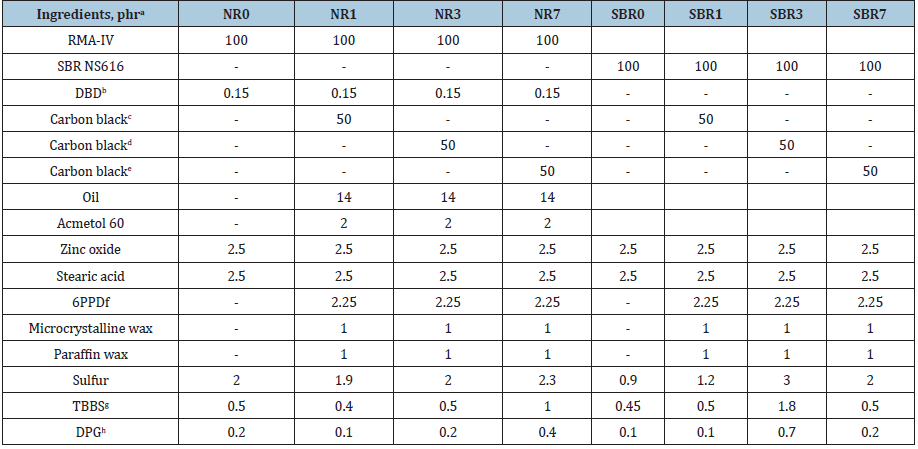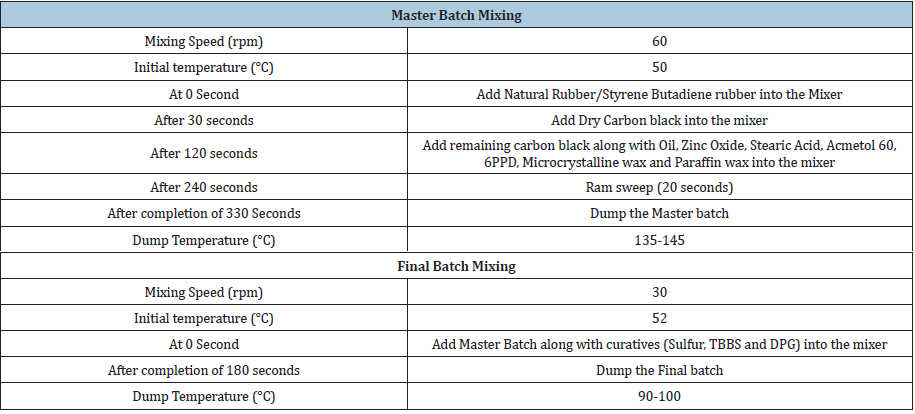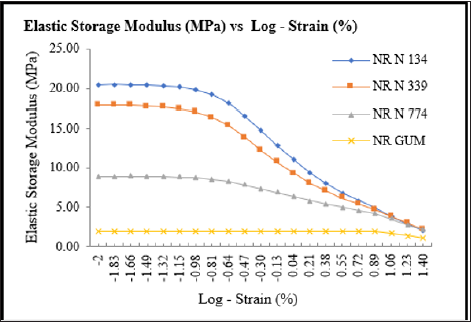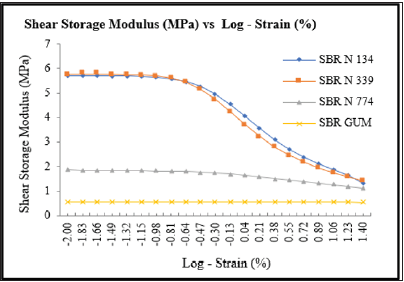- Submissions

Full Text
Polymer Science: Peer Review Journal
Quantitative Estimation of Filler-Filler Interaction of Rubber Vulcanizates Using Dynamic Mechanical Analyzer
Ajay C, Das R and Gupta SD*
Hari Shankar Singhania Elastomer and Tyre Research Institute (Hasetri), India
*Corresponding author:Saikat Das Gupta, Hari Shankar Singhania Elastomer and Tyre Research Institute (Hasetri), Mysuru-570016, India
Submission: March 19, 2021;Published: April 08, 2021

ISSN: 2770-6613 Volume1 Issue5
Abstract
For the superior performance of a vulcanized product, effective dispersion of fillers into rubber matrix is a most important requirement. A quantitative method of measuring filler to filler interaction by using Dynamic Mechanical Analyzer (DMA) is described here in this study. This method is based on a measurement of strain sweep on cured vulcanizate sample. The selected rubber matrixes were Natural Rubber (NR) and Styrene Butadiene Rubber (SBR), three different series of carbon black by varying the particle size was used as filler.
Keywords: Fillers; Mechanical analyzer; Natural rubber; Carbon; Vulcanizates; Matrix; Crystalline
Introduction
Carbon black and silica are the two most important fillers primarily used by most of the tyre industries. The desire for improving the product performance includes tread wear life, good traction and low rolling resistance leads to the use of silica along with carbon black by the industries [1]. The effective incorporation and dispersion of fillers into the rubber matrix is very important while considering the performance of the product. The elastic part of a filler network depend majorly on its structure property, but still the formation of filler network and the process of aggregation is still unclear [2]. The poor rubber filler interaction would lead to inferior product life, dull appearance of product, difficulty in processing, raw material, and energy wastage [3]. There are number of techniques available to qualitatively characterize the dispersion comprising inspection by naked eyes [4], microscopy [5], optical [6], reflectometry [7], profilometry [8], electrical resistivity [9], and many more. Based on the literature review, several research works have been published in studying the dispersion in un vulcanized rubber compounds and in related areas. In this present research, a focused approach has been applied to quantitatively estimate the filler-filler interaction in rubber vulcanizates by making use of Dynamic Mechanical Analyzer.
Experimental
Materials
All the ingredients used for mixing in the studies presented here were used as obtained. Natural Rubber (RMA IV) was supplied by JK Industries Pvt. Ltd., India and Styrene Butadiene rubber by Zeon India Pvt. Ltd. The other ingredients were 2,2’-Dithiobisbenzanilide (DBD; Acmechem Pvt. Ltd., India) N134, N339 and N774 carbon black (Birla Carbon Black India Pvt. Ltd., India), Oil of aromatic grade (Raj Petro, Chennai, India), zinc oxide (rubber grade; Zinc-o-India, India), stearic acid (Godrej Industries Ltd., India), Acmetol 60 (Acmechem, India), N-phenyl-N’-(1,3-dimethylbutyl) p-phenylene-diamine (6PPD; National Organic Chemicals Industries Ltd., India), micro crystalline wax and paraffin wax (Gujrat Paraffins Pvt. Ltd., India), N- tert-butyl-benzothiazole sulfonamide (TBBS; National Organic Chemicals, India Ltd., India), soluble sulfur (Jain Chemicals Ltd., India), and diphenyl guanidine (DPG; National Organic Chemicals, India Ltd., India) used for the compound preparation. The basic formulations of all the compounds are given in Table 1. The mixing of rubber compounds was carried out in a 1.51L volume Laboratory Banbury mixer (Stewart Bowling, USA) having two wing tangential rotor with a temperature control unit in two stages i.e master batch and final batch stage. Master batch stage mixing of compound was carried out by setting the Temperature Control Unit (TCU) at 90 °C and the rotor speed at 60 revolutions per minute (rpm). Primarily, the natural rubber was added into the mixer and masticated along with the peptiser (DBD) for 30s. Followed by, the carbon black, process oil, zinc oxide, stearic acid, process aids, anti-degradants were added into the mixer. The master batch was dumped after a total of 330s. The display dump temperature of the master batch compounds was found to be between 135 and 145 °C except for natural rubber gum compound which was mixed in a single batch. Final batch stage mixing of compound was carried out at TCU temperature 70 °C and the rotor speed at 30rpm. The master batch compound along with the curative package, viz, sulfur, TBBS and DPG was added into the mixer at 0s and dumped after 180s. The observed display dumb temperature of the final batch compound was found to be between 90-100 °C. The mixing sequence of Master and Final Batch is given in Table 2.
Table 1:Formulation of compounds.

aphr, parts per hundred rubber by weight
b2,2’-Dithiobisbenzanilide
cCarbon black grade N134
dCarbon black grade N339
eCarbon black grade N774
fN,N’-diphenyl-p-phenylenediamine
gN-tert-butyl-benzothiazole sulfonamide
hDiphenyl guanidine.
Table 2:Mixing sequence.

Dynamic Mechanic Analyzer
Strain sweep of cured rubber vulcanizates was performed by using Dynamic Mechanical analyzer from ACOEM, France. Cured test pieces were subjected to a strain sweep at constant temperature and frequency. The filled rubber dissipates energy during deformation, At low strains, rubbery materials exhibit a non-linear viscoelastic behavior which can be characterized by the drop in storage modulus [10]. The difference in storage modulus (E’/G’) between the high and low strain given the quantitative estimate of rubber filler interaction in cured vulcanizates. The tests were carried out both in tension and in shear mode. The specimen for tension mode was punched out from the slabs cured at 145 °C for twice tc90 and the double sandwich cylindrical specimen was prepared for the shear mode testing by using cured slabs. The geometry of a tension mode specimen was a strip of 25mm in length, 10mm in width and 2.0mm±0.2mm in thickness as given in Figure 1. The test length was 10mm±1.0mm with the remainder of the strip in the grips. The geometry of shear mode specimen containing two parallel rubber elements was having a thickness 2.00mm. The rubber elements were firmly attached to the metal cylinders having diameter of 10mm and height of 10mm which was held in the grip.
Figure 1: Strain sweep: Natural rubber: Tension mode.

Results and Discussion
Strain Sweep analysis performed on the cured rubber
vulcanizates to estimate the filler-filler interaction of compounds
quantitatively. Thereafter determined the storage modulus at all
the data points recorded during the test program in accordance
with ISO 4664-1. Calculated the average of difference in storage
modulus (ΔE’ or ΔG’) between the lowest applied (0,01%) and
the highest applied (25,00%) strain percentage of the test piece.
Highest possible strain subjected in this study was 25%.
ΔE´=E´ (0,01 %)-E´(25,00 %) “in tension mode”
ΔG´=G´ (0,01 %)-G´(25,00 %) “in shear mode”
(Table 3) summarized the difference in storage modulus
(ΔE´/ΔG´) between the highest and lowest strain applied for the
test. The filler-filler interaction in both the Natural Rubber (Figure
1-tension mode, Figure 2-shear mode) and Styrene Butadiene
Rubber (Figure 3-tension mode, Figure 4-shear mode) was found
to be increasing while decreasing the particle size of Carbon black.
It was observed that while going for large strain, the difference in
storage modulus values among the variants become in-significant
similar to un-vulcanizate rubber compound characteristics [11].
Table 3: Test results.

Figure 2: Strain sweep: Natural rubber: Shear mode.

Figure 3: Strain sweep: Styrene butadiene rubber: Tension mode.

Figure 4: Strain sweep: Styrene butadiene rubber: Shear mode.

Conclusion
Performance properties of rubber compound depend on the homogeneous filler distribution in the rubber matrix. Better dispersion of filler will achieve better reinforcing properties like modulus, tensile, elongation. There are several measurement techniques available to measure the filler distribution in rubber matrix. However, all such methods are used to check at the compound level filler dispersion. In the present study, it was shown that filler dispersion can also be measured from the cured product using dynamic mechanical analysis. The results shows that the rubber matrix with the lowest particle size carbon black has the highest filler-filler interaction and the matrix with highest particle size black shows the lowest filler-filler interaction. From the results, it can be inferred that the rubber filler matrix with the lowest filler-filler network shows better filler dispersion and results in improved performance properties. The studies carried out on both the Natural Rubber and Styrene Butadiene rubber supports the findings. The filler-filler interaction in rubber vulcanizates has been quantitatively estimated by using Dynamic mechanical analyzer.
Acknowledgement
The authors would like to thank the Management of Hari Shankar Singhania Elastomer and Tyre Research Institute for granting the permission to publish this work. The authors would also like to thank Vikram Manda for his assistance in performing the experiments.
References
- Lin CJ, Hergenrother WL, Alexanian E, Böhm GGA (2002) On the filler flocculation in silica-filled rubbers part I. quantifying and tracking the filler flocculation and polymer-filler interactions in the unvulcanized rubber compounds. Rubber Chemistry and Technology 75(5): 865-890.
- Meier JG, Kluppel M (2008) Carbon black networking in elastomers monitored by dynamic mechanical and dielectric spectroscopy. Macromol Mater Eng 293(1): 12-38.
- Ganesan L, Bhattacharyya P, Bhowmick AK (1995) Quantitative measurement of dispersion of carbon black in rubber by an image processing technique. J of Appl Polym Sci 56(13): 1739-1747.
- Wiegand WB (1926) Optimum cure criteria in vulcanized rubber. Canadian Chem Met 18(11): 1157-1163.
- Leigh Dugmore CH (1956) Measurement of dispersion in black-loaded rubber. Rubber Chem Technol 29(4): 1303-1308.
- Jansen J, Kraus G (1980) New methods for estimating dispersibility of carbon blacks in rubber. Rubber Chem Technol 53(1): 48-65.
- Gerspacher M, Nikiel L, Yang HH, Farrell CPO (1998) Reflectometry-A new method of measuring filler dispersion. Rubber Chem Technol 71(1): 17-25.
- (2003) ASTM Standard D2663-95a, Standard Test Methods for Carbon Black-Dispersion in Rubber, Annu. Book ASTM Stand, USA.
- Cembrola RJ (1983) Resistivity and surface roughness analyses for evaluating carbon black dispersion in rubber. Rubber Chem Technol 56(1): 233-243.
- Clément F, Bokobza L, Monnerie L (2005) Investigation of the payne effect and its temperature dependence on silica-filled polydimethylsiloxane networks. part I: experimental results. Rubber Chemistry and Technology 78(2): 211-231.
- Payne AR (1962) The dynamic properties of carbon black‐loaded natural rubber vulcanizates. Part I. Journal of Applied Polymer Science 6(19): 57-63.
© 2021 Gupta SD. This is an open access article distributed under the terms of the Creative Commons Attribution License , which permits unrestricted use, distribution, and build upon your work non-commercially.
 a Creative Commons Attribution 4.0 International License. Based on a work at www.crimsonpublishers.com.
Best viewed in
a Creative Commons Attribution 4.0 International License. Based on a work at www.crimsonpublishers.com.
Best viewed in 







.jpg)






























 Editorial Board Registrations
Editorial Board Registrations Submit your Article
Submit your Article Refer a Friend
Refer a Friend Advertise With Us
Advertise With Us
.jpg)






.jpg)














.bmp)
.jpg)
.png)
.jpg)










.jpg)






.png)

.png)



.png)






